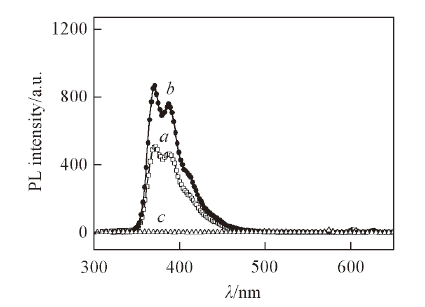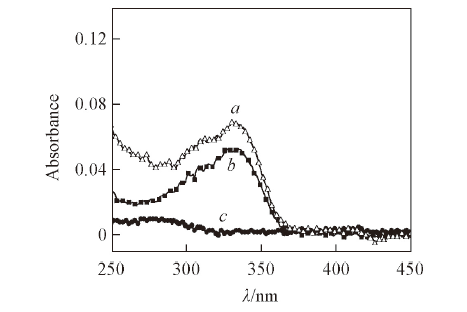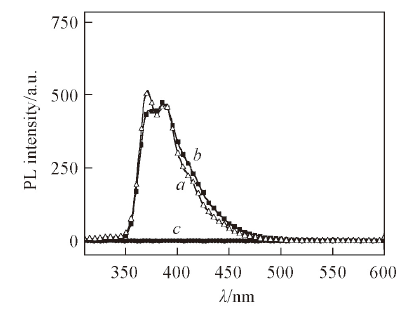

Chem. J. Chinese Universities ›› 2014, Vol. 35 ›› Issue (5): 1111.doi: 10.7503/cjcu20130840
• Polymer Chemistry • Previous Articles
LIU Nan, WU Yonggang, BAI Libin*( ), WANG Yuan, HUANG Haichao, ZHAO Hongchi, BA Xinwu*(
), WANG Yuan, HUANG Haichao, ZHAO Hongchi, BA Xinwu*( )
)
Received:2013-08-30
Online:2014-05-10
Published:2014-04-12
Contact:
BAI Libin,BA Xinwu
E-mail:zhonggou556@hbu.edu.cn;baxw@hbu.edu.cn
Supported by:CLC Number:
TrendMD:
LIU Nan, WU Yonggang, BAI Libin, WANG Yuan, HUANG Haichao, ZHAO Hongchi, BA Xinwu. Preparation of pH-Sensitive Fluorescent Poly(acryl-2-aminoethy-lammonium hydrochloride) with Porphyrin or Fluorene by One-pot Method†[J]. Chem. J. Chinese Universities, 2014, 35(5): 1111.

Fig.7 PL spectra of PBAEN(a), PBAEN-EPT(b) and EPT(c) at 25 ℃^a. [PBAEN]=2.5×10-6 mol/L, λex=288 nm;b. [EPT]=2.0×10-8 mol/L, λex=410 nm;c. [PBAEN-EPT]=2.5×10-6 mol/L, λex=410 nm.

Fig.8 UV-Vis spectra of PBAEN-EPT, PAEN-EPT and EPT at 25 ℃^a. [PAEN-EPT]=2.5×10-6 mol/L(aqueous solution);b. [EPT]=0(aqueous solution);c. [PBAEN-EPT]=2.5×10-6 mol/L(CH2Cl2 solution).

Fig.9 PL spectra of PBAEN-EPT, PAEN-EPT and EPT at 25 ℃(λex=410 nm)^a. [PAEN-EPT]=2.5×10-6 mol/L(aqueous solution); b. [EPT]=0(aqueous solution);c. [PBAEN-EPT]=2.5×10-6 mol/L(CH2Cl2 solution).

Fig.11 PL spectra of PBAEN, PBAEN-DEPF and DEPF at 25 ℃^a. [PBAEN]=7.5×10-6 mol/L, λex=288 nm;b. [PBAEN-DEPF]=7.5×10-6 mol/L, λex=300 nm; c. [DEPF]=2.0×10-8 mol/L, λex=300 nm.

Fig.12 UV-Vis spectra of PBAEN-DEPF(a),PAEN-DEPF(b) and DEPF(c) at 25 ℃^a. [PBAEN-DEPF]=7.5×10-6 mol/L;b. [PAEN-DEPF]=7.5×10-6 mol/L(aqueous solution);c. [DEPF]=0(aqueous solution).

Fig.13 PL spectra of PBAEN-DEPF(a), PAEN-DEPF(b) and DEPF(c) at 25 ℃^a. [PBAEN-DEPF]=7.5×10-6 mol/L, λex=288 nm;b. [PAEN-DEPF]=7.5×10-6 mol/L(aqueous solution);c. [DEPF]=0(aqueous solution), λex=288 nm.
| [1] | Wu Z. Q., Meng L. Z., Prog. Chem., 2007, 19(9), 1381—1390 |
| (武照强, 孟令芝.化学进展, 2007,19(9), 1381—1390) | |
| [2] | Wang W. Z., Fan Q. L., Cheng F., Zhao P., Huang W., J. Poly. Sci. Part A: Polym. Chem., 2006, 44(11), 3513—3525 |
| [3] | Wang B.Y., Studies on Design, Synthesis and Photophysical Properties of Water-Soluble Fluorescent Polymers, Lanzhou University, Lanzhou, 2009 |
| (王宝燕. 水溶性荧光聚合物的设计、 合成与荧光性质研究, 兰州: 兰州大学, 2009) | |
| [4] | Richa R., Gysel H., Schneider J., Macromolecules, 1987, 20(6), 1407—1411 |
| [5] | Kolb H. C., Finn M. G., Sharpless K. B., Angew. Chem. Int. Ed., 2001, 40(11), 2004—2021 |
| [6] | Zhang Q., Wang B., Li X., Bai F., Sun D., Bai G., Chem. J. Chinese Universities, 2011, 32(2), 281—285 |
| (张奇, 王彬, 黎霞, 候洁, 白芳, 孙丹, 白钢.高等学校化学学报, 2011,32(2), 281—285) | |
| [7] | Carioscia J. A., Tansbury J. W., Bowman C. N., Polymer, 2007, 48(6), 1526—1532 |
| [8] | Bai L. B., Zheng R. R., Li W. L., Wu Y. G., Ba X. W., Wang H. J., Chin. J. Polym. Sci., 2013, 31(7), 1038—1045 |
| [9] | Liu Y., Synthesis of a Novel Thermo-Sensitive Polymer Containing Serine Moieties and the Performance Study of Its Aqueous Solution, Hefei University of Technology, Hefei, 2010 |
| (刘洋. 含丝氨酸结构温敏聚合物的合成及其水溶液的温敏特性研究, 合肥: 合肥工业大学, 2010) | |
| [10] | Scales C. W., Convertine A. J., McCormick C. L., Biomacromolecules, 2006, 7(5), 1389—1392 |
| [11] | John T. L., Debby F., Ronald S., Macromolecules, 2002, 35(18), 6754—6756 |
| [12] | Sung H. J., Seung Y. K., Mi Y. K., Macromolecules, 2003, 36(11), 3841—3847 |
| [13] | Guo X. M., Guo B., Chen Y. H., Chem. J. Chinese Universities, 2013, 34(3), 499—502 |
| (郭喜明, 郭斌, 陈业宏.高等学校化学学报, 2013,34(3), 499—502 | |
| [14] | Sun M., Zhang H. Y., Liu B. W., Liu Y., Macromolecules, 2013, 46(11), 4268—4275 |
| [1] | WANG Zhengwen, GAO Fengxiang, CAO Han, LIU Shunjie, WANG Xianhong, WANG Fosong. Synthesis and Property of CO2 Copolymer⁃based UV-curable Polymer [J]. Chem. J. Chinese Universities, 2022, 43(7): 20220236. |
| [2] | YANG Zhaohua, CHENG Hongjing, YANG Yi, LIU Hui, DU Feipeng, ZHANG Yunfei. Preparation of Silver-loaded Polyvinyl Alcohol Sponge and Its Interfacial Photothermal Driven Water Evaporation Performance [J]. Chem. J. Chinese Universities, 2022, 43(10): 20220181. |
| [3] | ZHOU Jieqiong, HUANG Yan, ZHANG Zhiling, PANG Daiwen, TIAN Zhiquan. Water-soluble Ag2Te Quantum Dots with Emission in the Second Near-infrared Window [J]. Chem. J. Chinese Universities, 2021, 42(6): 2072. |
| [4] | YANG Ju, SU Lijiao, LI Canhua, LU Jiajia, YANG Junli, GU Jie, YANG Li, YANG Lijuan. Host-guest Complexation Behavior of Nardosinone and Water-soluble Phosphate Salt Pillar[6]arene [J]. Chem. J. Chinese Universities, 2021, 42(10): 3099. |
| [5] | CAO Meng, LIU Yang, ZHANG Shangxi, WANG Zhenxi, XU Sheng. Synthesis and Photocatalytic Hydrogen Evolution Properties of Chitosan Cobalt Complex † [J]. Chem. J. Chinese Universities, 2020, 41(4): 735. |
| [6] | WANG Shanshan, CAI Chao, HAO Jiejie, LI Guoyun, WANG Xueliang, HU Minghua, FAN Luodi, YU Guangli. Preparation and Immunological Activity Evaluation of Water-soluble β-Glucan from Saccharomyces cerevisiae † [J]. Chem. J. Chinese Universities, 2019, 40(9): 1873. |
| [7] | FANG Chao,ZHU Hanyu,LIU Ye,ZHAO Waiou,LI Yapeng,WANG Jingyuan. Synthesis and Characterization of Nanoparticles with Hydrogen Peroxide Sensitivity, Targeting and Fluorscence for Atherosclerosis [J]. Chem. J. Chinese Universities, 2018, 39(9): 2071. |
| [8] | LING Yao, LIU Xuejing, HAO Haijing, HAO Xiaohui, BAI Libin, WU Yonggang. Synthesis and Properties of Water-soluble Glycosyl Fluorescent Polymer with Aggregation-induced Emission Effect† [J]. Chem. J. Chinese Universities, 2018, 39(6): 1319. |
| [9] | LUO Juxiang, CHENG Deshu, LI Mingchun, XIN Meihua. Visible Light Induced Rapid Reversible Addition-fragmentation Chain Transfer Polymerization(RAFT )of Styrene at Room Temperature† [J]. Chem. J. Chinese Universities, 2018, 39(4): 800. |
| [10] | SUN Kaifang, CAI Cheng, HOU Zongsheng, WANG Ying, REN Qizhi. Synthesis, Characterization and Catalytic Properties of Series of Water-soluble Sulfonated Porphyrins† [J]. Chem. J. Chinese Universities, 2017, 38(7): 1117. |
| [11] | LI Xingjian,JU Yunpeng,CHANG Degong,ZHANG Yiheng. Preparation and Properties of Flame Retardant Waterborne Polyurethane Nanocomposites via Click Reaction† [J]. Chem. J. Chinese Universities, 2016, 37(8): 1580. |
| [12] | SUN Haijie, CHEN Lingxia, HUANG Zhenxu, LIU Shouchang, LIU Zhongyi. Particle Size Effect of Ru-Zn Catalysts on Selective Hydrogenation of Benzene to Cyclohexene† [J]. Chem. J. Chinese Universities, 2015, 36(10): 1969. |
| [13] | HUANG Yan-Qin, QIN Wei-Sheng, REN Hou-Ji, CAO Guo-Yi, LIU Xing-Fen, HUANG Wei. Novel Adenosine Detection Method Based on Cationic Conjugated Polymer and Aptamer [J]. Chem. J. Chinese Universities, 2012, 33(10): 2213. |
| [14] | GUO Zhi-Fo, YAN Hao, LI Zhi-Fen, LU Zhong-Lin*. Synthesis of New [12]aneN3 Compounds and Their Catalytic Cleavage of Phosphodiester [J]. Chem. J. Chinese Universities, 2011, 32(9): 2128. |
| [15] | ZHANG Xiao-Ping, HUANG Yan-Qin*, FAN Chun-Hai, HUANG Wei*. Novel Method of Phosphatase Detection Based on Cationic Conjugated Polymer and Enzymatic Substrate Probe [J]. Chem. J. Chinese Universities, 2011, 32(11): 2548. |
| Viewed | ||||||
|
Full text |
|
|||||
|
Abstract |
|
|||||